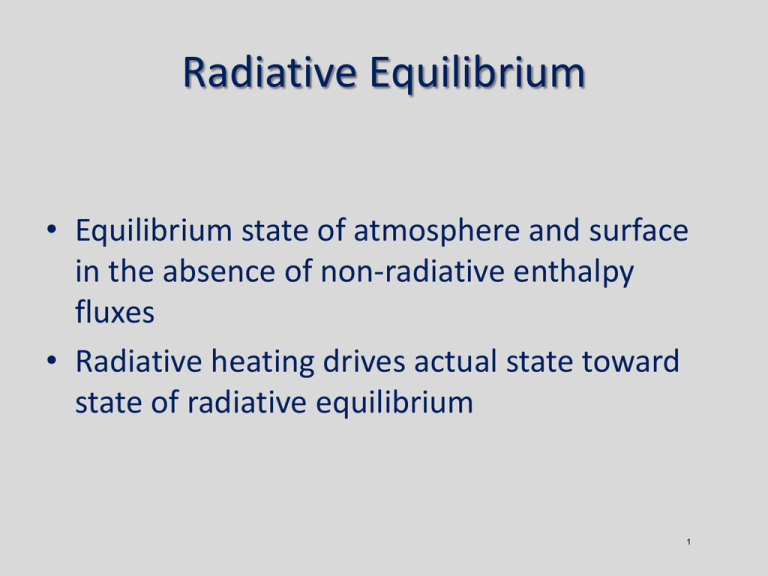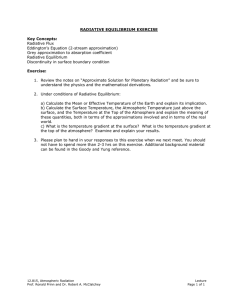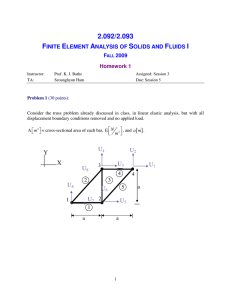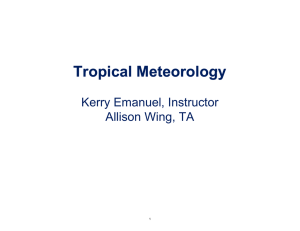Radiative Equilibrium
advertisement

Radiative Equilibrium • Equilibrium state of atmosphere and surface in the absence of non-radiative enthalpy fluxes • Radiative heating drives actual state toward state of radiative equilibrium 1 Figure by MIT OpenCourseWare. 2 Extended Layer Models TOA : T2 4 Te 4 T2 Te Middle Layer : 2 T T2 Ts Te Ts 4 1 4 4 4 Surface : Ts 4 Te 4 T14 1 Ts 3 Te 4 1 T1 2 4 Te 3 4 Effects of emissivity<1 Surface : 2 A TA 4 A T14 A Ts 4 2 TA 5 1 4 Te 321K Ts Stratosphere : 2 t Tt 4 t T2 4 2 Tt 1 1 4 Te 214 K Te 4 Full calculation of radiative equilibrium 5 Figure by MIT OpenCourseWare. 6 Time scale of approach to equilibrium 7 8 Contributions of various absorbers Note: All simulations have variable clouds interacting with radiation 9 10 Problems with radiative equilibrium solution • Too hot at and near surface • Too cold at a near tropopause • Lapse rate of temperature too large in the troposphere • (But stratosphere temperature close to observed) 11 Missing ingredient: Convection • As important as radiation in transporting enthalpy in the vertical • Also controls distribution of water vapor and clouds, the two most important constituents in radiative transfer 12 13 When is a fluid unstable to convection? • Pressure and hydrostatic equilibrium • Buoyancy • Stability 14 Hydrostatic equilibrium Weight : g x y z Pressure : p x y p p x y dw F MA : x y z g x y z p x y dt dw p g , 1 specific volume dt z 15 Pressure distribution in atmosphere at rest RT R* Ideal gas : , R p m 1 p g Hydrostatic : p z RT Isothermal case : p p0 e z H , RT H " scale height " g Earth: H~ 8 Km 16 Buoyancy Weight : g b x y z Pressure : p x y p p x y dw F MA : b x y z g b x y z p x y dt dw p p but g b g e dt z z b e dw g B dt e 17 Buoyancy and Entropy Specific Volume: Specific Entropy: 1 s ( p, s) T s s s p p s Bg p p g T T s s s p s z s 18 The adiabatic lapse rate First Law of Thermodynamics : dsrev dT d cv p Q T dt dt dt dT d p dp cv dt dt dt dT dp cv R dt dt dT dp cp dt dt Adiabatic : c p dT dp 0 Hydrostatic : c p dT gdz 0 dT dz g s cp d 19 g Earth’s atmosphere: cp 1 K 100 m 20 Model Aircraft Measurements (Renno and Williams, 1995) This image (published on Monthly Weather Review by the American Meteorological Society) is copyright © AMS and used with permission. 21 Radiative equilibrium is unstable in the troposphere Re-calculate equilibrium assuming that tropospheric stability is rendered neutral by convection: Radiative-Convective Equilibrium 22 Better, but still too hot at surface, too cold at tropopause 23 MIT OpenCourseWare http://ocw.mit.edu 12.340 Global Warming Science Spring 2012 For information about citing these materials or our Terms of Use, visit: http://ocw.mit.edu/terms.







